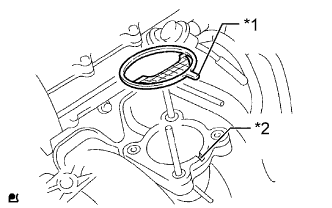Throttle Body -- Installation |
| 1. INSTALL THROTTLE BODY WITH MOTOR ASSEMBLY |
Install a new gasket on the intake manifold.
Text in Illustration *1 Protrusion *2 Groove - HINT:
- Align the protrusion of the gasket with the groove of the intake manifold.
 |
Install the throttle body with motor the 2 bolts and 2 nuts.
- Torque:
- 9.0 N*m{92 kgf*cm, 80 in.*lbf}
Connect the 2 water by-pass hoses to the throttle body with motor.
Connect the throttle position sensor and control motor connector.
| 2. INSTALL INTAKE AIR CONNECTOR |
Install the intake air connector with the 2 bolts, and tighten the 2 hose clamps.
- Torque:
- for intake air connector:
- 8.0 N*m{82 kgf*cm, 71 in.*lbf}
- for hose clamp throttle body side:
- 5.0 N*m{51 kgf*cm, 44 in.*lbf}
- for hose clamp air cleaner side:
- 4.0 N*m{41 kgf*cm, 35 in.*lbf}
Connect the vacuum hose.
Connect the No. 2 ventilation hose.
| 3. ADD ENGINE COOLANT |
Tighten all the plugs and fill the radiator with TOYOTA Super Long Life Coolant (SLLC).
- Torque:
- for Cylinder block drain cock plug:
- 13 N*m{130 kgf*cm, 9 ft.*lbf}
- Standard Capacity:
Item Specified Condition A/T 8.1 liters (8.6 US qts, 7.1 Imp. qts) M/T 7.8 liters (8.2 US qts, 6.9 Imp. qts)
- NOTICE:
- Never use water as a substitute for engine coolant.
- HINT:
- TOYOTA vehicles are filled with TOYOTA SLLC at the factory. In order to avoid damage to the engine cooling system and other technical problems, only use TOYOTA SLLC or similar high quality ethylene glycol based non-silicate, non-amine, non-nitrite, non-borate coolant with long-life hybrid organic acid technology (coolant with long-life hybrid organic acid technology is a combination of low phosphates and organic acids).
- Please contact your TOYOTA dealer for further details.
Fill the radiator reservoir with TOYOTA SLLC to the F line.
Press the inlet and outlet radiator hoses several times by hand, and then check the level of the coolant.
If the coolant level drops below the F line, add TOYOTA SLLC to the F line.
Install the radiator cap.
Bleed air from the cooling system.
Warm up the engine until the thermostat opens.
While the thermostat is open, circulate the coolant for several minutes.Maintain the engine speed at 2500 to 3000 rpm.
Press the inlet and outlet radiator hoses several times by hand to bleed air.
- CAUTION:
- When pressing the radiator hoses:
- Wear protective gloves.
- Be careful as the radiator hoses are hot.
- Keep your hands away from the radiator fan.
Stop the engine and wait until the coolant cools down to ambient temperature.
- CAUTION:
- Do not remove the radiator cap while the engine and radiator are still hot. Pressurized, hot engine coolant and steam may be released and cause serious burns.
Check the coolant level in the radiator reservoir.
If the coolant level is below the L line, add SLLC up to the reservoir F line.
| 4. PERFORM INITIALIZATION |
- NOTICE:
- Perform the following procedure after replacing or removing and installing the ECM, throttle body or any throttle body components or after reconnecting the battery cable. The following procedure should also be performed if the throttle body is cleaned.
Disconnect the EFI and ETCS fuses at the same time. Wait at least 60 seconds and reconnect the fuses.
Turn the ignition switch to ON without operating the accelerator pedal.
- NOTICE:
- If the accelerator pedal is operated, perform the above steps again.
Connect the tester to the DLC3 and clear the DTCs (HILUX_TGN26 RM000000PDK0T7X.html).
Start the engine and check that the MIL is not illuminated and that the idle speed is within the specified range when the cooler is switched off after the engine is warmed up.
- Engine Idle Speed:
Condition Specified Condition Air conditioning switched off 600 to 700 rpm
- NOTICE:
- Be sure to perform this step with all accessories off.
- Make sure that the shift lever is in neutral.
Enter the following menus: Powertrain / Engine and ECT / Data List / Throttle Sensor Position. Fully depress the accelerator pedal and check that the value is 60% or more.
Perform a road test and confirm that there are no abnormalities.
| 5. INSPECT FOR COOLANT LEAKS |
- CAUTION:
- Do not remove the radiator cap while the engine and radiator are still hot. Pressurized, hot engine coolant and steam may be released and cause serious burns.
Fill the radiator with coolant and attach a radiator cap tester.
Warm up the engine.
Using a radiator cap tester, increase the pressure inside the radiator to 118 kPa (1.2 kgf/cm2, 17 psi), and check that the pressure does not drop.
If the pressure drops, check the hoses, radiator and water pump for leaks. If no external leaks are found, check the cylinder block and cylinder head.